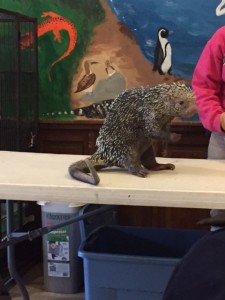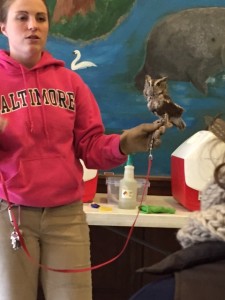During class the other day it was discussed that perhaps zoos and taxidermy displays are similar. While animals are killed, taxidermied, and often put on display for our viewing, animals at zoos are put on display in small enclosures for our viewing. This idea resonated with me while on my conservation biology class trip to the Lehigh Valley Zoo. Initially as the guide started pulling animals out in an exhibit room I felt this way. I felt as though these animals were be kept in cages, handled, and shown for our benefit. However, after reading more about this zoo and hearing about this zoo from the guides and Doc R, I found this zoo does not keep animals just to display them. The Lehigh Valley Zoo is part of the Association of Zoos and Aquariums (AZA) meaning it emphasizes the importance of conservation to guests, contributes to field conservation, and contributes, participates in, and initiates wildlife conservation programs at home and in the field.
As Erik mentioned in his earlier post on the zoo, the Lehigh Valley Zoo contains more than 294 animal ambassadors representing 88 species, 24 of which are considered to be endangered, threatened, or species of concern. The endangered and threatened species at this zoo are bred in captivity to contribute to the Species Survival Plan (SSP). The SSP is a plan in which threatened and endangered species at zoos have their genetics cataloged and mates that will produce offspring with genes most beneficial for contributing to the specie’s gene pool are matched across the nation. The resulting higher diversity gene pool gives species a better chance of surviving and re-establishing numbers to deliver them from the endangered and threatened classification. The guide specifically told us a great deal about this program in relation to their Black-Footed African Penguins since they currently have a female mate in from a zoo in New York for one of their males in hopes they will produce viable offspring due to their compatible genes. Unfortunately their offspring will be sent to another zoo for breeding, but the hope is that that next generation could be placed in the wild to help bring numbers back up. As well, the remaining species here that are not part of SSP are either being studied for conservation research or they came here due to injury that prevents them from surviving in the wild. Hearing about this program and the reasons why the animals at the Lehigh Valley Zoo are there shed some light on zoos for me, as I realized the ultimate goal of this zoo is to benefit the species, conserve nature, and educate the public about conservation.
This is a Prehensile Porcupine (Coendou prehensilis), one of the SSP species at the Lehigh Valley Zoo.
Injured Eastern Screech Owl (Megascops asio)
Despite the good intentions of this place to conserve species and educate others about conservation, it was saddening to see these animals in captivity are put on display; it would appear that is trade off for zoos to have the funding for conserving and caring for these species. It is unfortunate that one of our methods for conserving endangered and threatened species involves the captivity of individuals, but hopefully this is worth it and will benefit these species in the long run.


